-
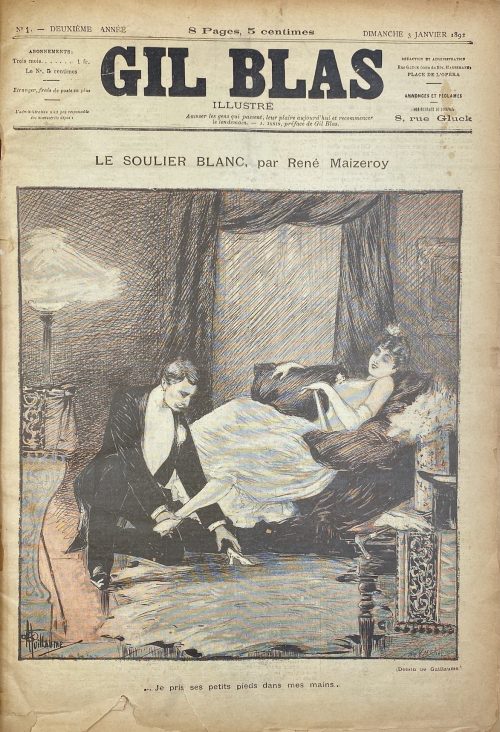 52 issues of French weekly Gil Blas illustré, 1892: №№ 1-52; published in Paris, 39 x 29 cm, bound in red half cloth over marbled boards, with gilt fillets and lettering to spine, marbled endpapers, profusely illustrated by Théophile Steinlen (Swiss-French, 1859 – 1923) and Albert Guillaume (French, 1873 – 1942).
52 issues of French weekly Gil Blas illustré, 1892: №№ 1-52; published in Paris, 39 x 29 cm, bound in red half cloth over marbled boards, with gilt fillets and lettering to spine, marbled endpapers, profusely illustrated by Théophile Steinlen (Swiss-French, 1859 – 1923) and Albert Guillaume (French, 1873 – 1942). -
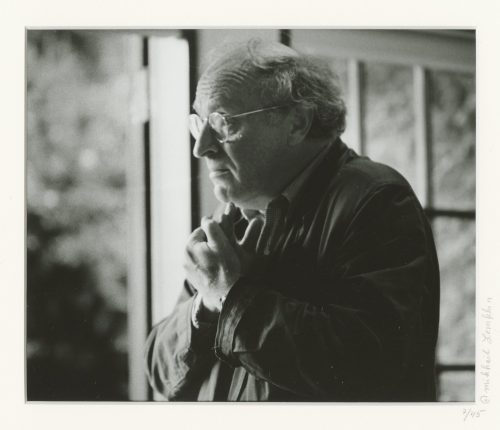 Photographic portrait of poet Joseph Brodsky, short half-length, turned to the left, with arms crossed on his breast. Pencil-signed on the mat: 7/45 • Mikhail Lemkhin; same inscription on the back of the print, and ink stamp ©Mikhail Lemkhin. Sitter: Joseph Brodsky [Иосиф Александрович Бродский ] (Russian-American-Jewish, 1940 – 1996). Size: mat: 35.7 x 43.3 cm; window: 19.5 x 23 cm; print: 20.3 x 25.3 cm.
Photographic portrait of poet Joseph Brodsky, short half-length, turned to the left, with arms crossed on his breast. Pencil-signed on the mat: 7/45 • Mikhail Lemkhin; same inscription on the back of the print, and ink stamp ©Mikhail Lemkhin. Sitter: Joseph Brodsky [Иосиф Александрович Бродский ] (Russian-American-Jewish, 1940 – 1996). Size: mat: 35.7 x 43.3 cm; window: 19.5 x 23 cm; print: 20.3 x 25.3 cm. -
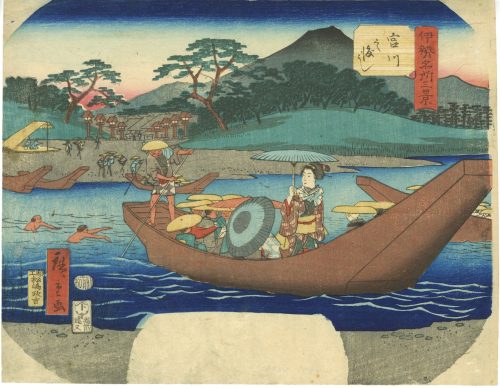 Artist: Utagawa Hiroshige II (二代目 歌川広重] (Japanese, 1826 – 1869). Signed: Hiroshige ga. Publisher: Enshūya Matabei [遠州屋又兵衛] (Japanese, fl. c. 1768 – 1881); (Enmata [遠又]), seal 22-009 (Marks). Block carver: Matsushima Masakichi (Japanese, fl. c. 1847-65); seal: [松嶋彫政] – Hori Masa (Frieze, 2009: 142). Combined date seal and kiwame censor seal: Bunkyū 2 (1862). Media: Fan print (uchiwa-e, 団扇絵), 230 x 298 mm Series: Three Famous Views in Ise [伊勢名所三景] (Ise meisho sankei).
Artist: Utagawa Hiroshige II (二代目 歌川広重] (Japanese, 1826 – 1869). Signed: Hiroshige ga. Publisher: Enshūya Matabei [遠州屋又兵衛] (Japanese, fl. c. 1768 – 1881); (Enmata [遠又]), seal 22-009 (Marks). Block carver: Matsushima Masakichi (Japanese, fl. c. 1847-65); seal: [松嶋彫政] – Hori Masa (Frieze, 2009: 142). Combined date seal and kiwame censor seal: Bunkyū 2 (1862). Media: Fan print (uchiwa-e, 団扇絵), 230 x 298 mm Series: Three Famous Views in Ise [伊勢名所三景] (Ise meisho sankei). -
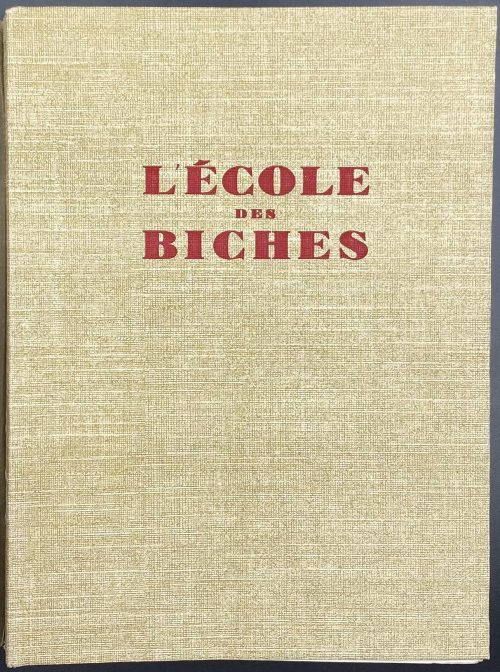 Softcover volume, 22.8 x 17 cm, French flapped wrapper simulating unprimed canvas with crimson lettering to front; pp.: ffl, [5/6] h.t., [7/8] t.p., 9-109 [110], [111/112] limitation/blank, ffl; plus 12 colour lithographs by Schem (Raoul Serres), incl. frontispiece; printed on wove paper. Title-page (red and black): L'ÉCOLE | DES | BICHES | OU | MŒURS DES | PETITES DAMES DE CE TEMPS | [blank] | M. CM. XXXIX. || Limitation: printed 99 copies of which this is № 27; date of printing July 10, 1939. Catalog raisonné: Dutel III № 1447. As per J.-P. Dutel (II № 231 pp 119-20), the text was published in Brussels in 1868 by Jean-Pierre Blanche. Presumed authors are Alfred Bégis, Frederick Hankey and Edmund Duponchel. [BEGIS, Alfred, with DUPONCHEL, Edmond, and HANKEY, Frederick, attributed to.] L'École des Biches ou Mœurs des petites dames de ce temps. Paris [but Brussels]: [Jean-Pierre Blanche,] 1863 [1868] sold at Christie’s for GBP 1,000 on November 18, 2014. For details, see [LIB-2812.2021] Highlights from the Erotica Library of Tony Fekete / Auction catalogue, Tuesday 18 November 2014. — London: Christie's, 2014. — Lot 36. Contributors: Alfred Bégis (French, 1829 – 1904) – author. Frederick Hankey (British, 1823 – 1882) – author. Edmund Duponchel (French, c. 1795 – 1868) – author. Jean-Pierre Blanche (Beligian, second half of the 19th century) – publisher. Schem [real name Raoul Serres] (French, 1881– 1971) – artist.
Softcover volume, 22.8 x 17 cm, French flapped wrapper simulating unprimed canvas with crimson lettering to front; pp.: ffl, [5/6] h.t., [7/8] t.p., 9-109 [110], [111/112] limitation/blank, ffl; plus 12 colour lithographs by Schem (Raoul Serres), incl. frontispiece; printed on wove paper. Title-page (red and black): L'ÉCOLE | DES | BICHES | OU | MŒURS DES | PETITES DAMES DE CE TEMPS | [blank] | M. CM. XXXIX. || Limitation: printed 99 copies of which this is № 27; date of printing July 10, 1939. Catalog raisonné: Dutel III № 1447. As per J.-P. Dutel (II № 231 pp 119-20), the text was published in Brussels in 1868 by Jean-Pierre Blanche. Presumed authors are Alfred Bégis, Frederick Hankey and Edmund Duponchel. [BEGIS, Alfred, with DUPONCHEL, Edmond, and HANKEY, Frederick, attributed to.] L'École des Biches ou Mœurs des petites dames de ce temps. Paris [but Brussels]: [Jean-Pierre Blanche,] 1863 [1868] sold at Christie’s for GBP 1,000 on November 18, 2014. For details, see [LIB-2812.2021] Highlights from the Erotica Library of Tony Fekete / Auction catalogue, Tuesday 18 November 2014. — London: Christie's, 2014. — Lot 36. Contributors: Alfred Bégis (French, 1829 – 1904) – author. Frederick Hankey (British, 1823 – 1882) – author. Edmund Duponchel (French, c. 1795 – 1868) – author. Jean-Pierre Blanche (Beligian, second half of the 19th century) – publisher. Schem [real name Raoul Serres] (French, 1881– 1971) – artist. -
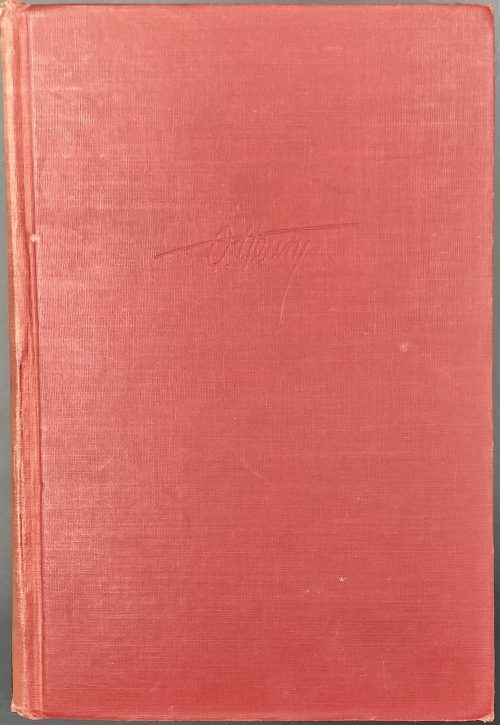 Hardcover volume, 21.5 x 14.7 x 5.7 cm, bound in red cloth with blind-stamped ms signature to front board and gilt lettering over black labels, and gild design elements to spine; pp.: [i-iv] (h.t./blank, t.p./copyright) v-xv[xvi] blank, [1-2] f.t./blank, 3-1653 [1654] blank, [2] publ. note/blank; 1672 pp total; Blue ink ms inscription to h.t. 'Lawrence Wyman'. Title-page (in a two-rule frame): THE COMPLETE WORKS OF | O. Henry | Foreword by | WILLIAM LYON PHELPS | AUTHENTIC EDITION | {publisher’s device, G.C.P.} | De Luxe Edition | — | Garden City Publishing Co., Inc. | GARDEN CITY NEW YORK || Contributors: O. Henry [William Sydney Porter] (American, 1862 – 1910) – author. William Lyon Phelps (American, 1865 – 1943) – author/foreword.
Hardcover volume, 21.5 x 14.7 x 5.7 cm, bound in red cloth with blind-stamped ms signature to front board and gilt lettering over black labels, and gild design elements to spine; pp.: [i-iv] (h.t./blank, t.p./copyright) v-xv[xvi] blank, [1-2] f.t./blank, 3-1653 [1654] blank, [2] publ. note/blank; 1672 pp total; Blue ink ms inscription to h.t. 'Lawrence Wyman'. Title-page (in a two-rule frame): THE COMPLETE WORKS OF | O. Henry | Foreword by | WILLIAM LYON PHELPS | AUTHENTIC EDITION | {publisher’s device, G.C.P.} | De Luxe Edition | — | Garden City Publishing Co., Inc. | GARDEN CITY NEW YORK || Contributors: O. Henry [William Sydney Porter] (American, 1862 – 1910) – author. William Lyon Phelps (American, 1865 – 1943) – author/foreword. -
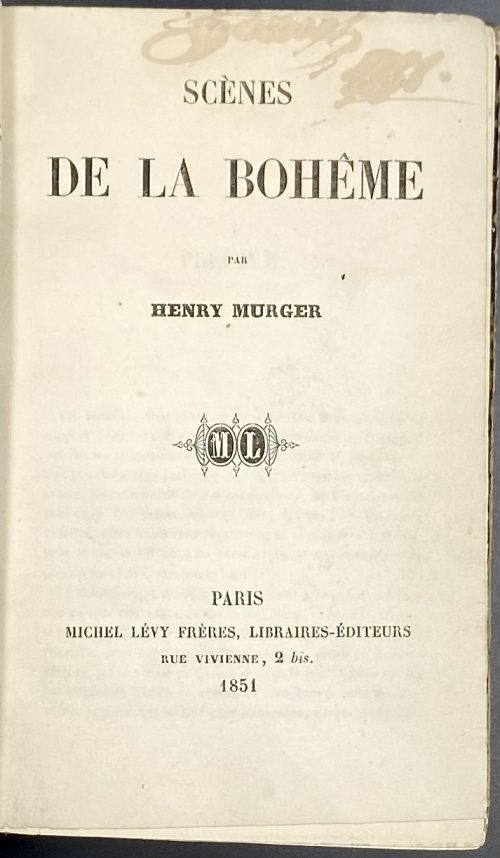 Hardcover volume, 18.2 x 11.8 cm, bound in quarter black polished calf with gilt lettering “cartonnage romantique” design to spine, marbled boards, matching marbled endpapers, blue margins. Title-page: SCÈNES | DE LA BOHÊME | PAR | HENRY MURGER | {publisher’s device ML} | PARIS | MICHEL LÉVY FRÈRES, LIBRAIRES-ÉDITEURS | RUE VIVIENNE, 2 bis. | 1851 || Half-title: ŒUVRES | D’HENRY MURGER || Advertisement: Chez le même Éditeurs. | BIBLIOTHEQUE CONTEMPORAINE | (page of text) || Collation: π2 (h.t/advert., t.p. / blank), 1-33 (17)12, χ6; total 212 leaves without ffls (3 front, 2 back). Pagination: [2] – h.t. / blank, [2] – t.p. / blank, [i] ii-xiii [xiv blank], [1] 2-406; total 424 pages. Scènes de la bohême, in later editions Scènes de la vie de bohème. Translations: Into English: LIB-2719.2021. Henri Murger. The Bohemians of the Latin Quarter. (Scènes de la vie de Bohême) / Translated from the French. — London: Vizetelly & Co., 1883. Into German: LIB-2686.2021. Henri Murger. Die Bohème : Szenen aus dem Pariser Künstlerleben. — Leipzig: Insel-Verlag, 1906. Into Russian: LIB-3182.2023. А. Мюрже. Сцены из жизни богемы / Пер. с франц. и прим. Е. А. Гунста; вст. ст. С. И. Великовского; художник Н. А. Кравченко. — М.: Художественная литература, 1963. Contributors: Murger, Henri [Henry] (French, 1822 – 1861) – author.
Hardcover volume, 18.2 x 11.8 cm, bound in quarter black polished calf with gilt lettering “cartonnage romantique” design to spine, marbled boards, matching marbled endpapers, blue margins. Title-page: SCÈNES | DE LA BOHÊME | PAR | HENRY MURGER | {publisher’s device ML} | PARIS | MICHEL LÉVY FRÈRES, LIBRAIRES-ÉDITEURS | RUE VIVIENNE, 2 bis. | 1851 || Half-title: ŒUVRES | D’HENRY MURGER || Advertisement: Chez le même Éditeurs. | BIBLIOTHEQUE CONTEMPORAINE | (page of text) || Collation: π2 (h.t/advert., t.p. / blank), 1-33 (17)12, χ6; total 212 leaves without ffls (3 front, 2 back). Pagination: [2] – h.t. / blank, [2] – t.p. / blank, [i] ii-xiii [xiv blank], [1] 2-406; total 424 pages. Scènes de la bohême, in later editions Scènes de la vie de bohème. Translations: Into English: LIB-2719.2021. Henri Murger. The Bohemians of the Latin Quarter. (Scènes de la vie de Bohême) / Translated from the French. — London: Vizetelly & Co., 1883. Into German: LIB-2686.2021. Henri Murger. Die Bohème : Szenen aus dem Pariser Künstlerleben. — Leipzig: Insel-Verlag, 1906. Into Russian: LIB-3182.2023. А. Мюрже. Сцены из жизни богемы / Пер. с франц. и прим. Е. А. Гунста; вст. ст. С. И. Великовского; художник Н. А. Кравченко. — М.: Художественная литература, 1963. Contributors: Murger, Henri [Henry] (French, 1822 – 1861) – author. -
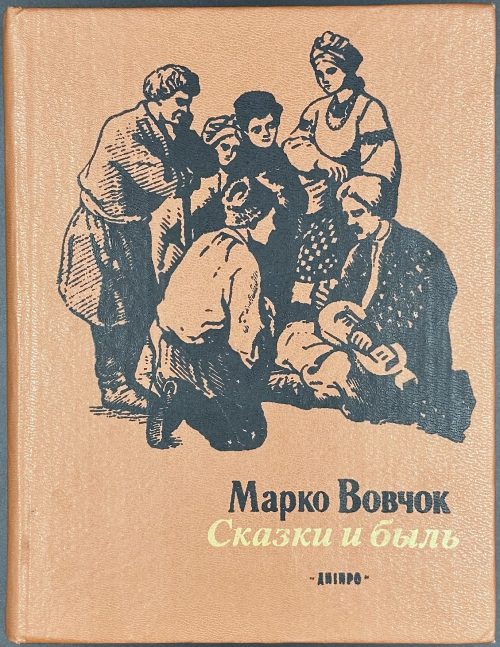 Small volume, 17.2 x 13.2 cm, brown buckram with vignette and lettering to front and spine, pp.: [1-4] 5-315 [5], illustrations: portrait, frontispiece, and two vignettes by I. Gavriliuk; text on Ukrainian and Russian. A reprint of the 1874 edition. Contents: Дев’ять братiв i десята сестриця Галя, Невiльничка, Ведмiдь, Кармелюк, Совершенная курица, Королевна Я, Затейник, Похождения домашнего учителя, Воришка, Чортова пригода. Title-page: Марко Вовчок | Сказки и быль | {vignette} | КИЕВ | ИЗДАТЕЛЬСТВО | ХУДОЖЕСТВЕННОЙ ЛИТЕРАТУРЫ | «ДНIПРО» | 1988 || Print run: 250,000 copies. Contributors: Марко Вовчок [Marko Vovchok; Марія Олександрівна Вілінська] (Ukrainian, 1833 – 1907) – author. Other variants: Markowovzok and Marko Vovtchok. Іван Михайлович Гаврилюк (Иван Михайлович Гаврилюк) (Ukrainian, 1939 – 2008) – artist.
Small volume, 17.2 x 13.2 cm, brown buckram with vignette and lettering to front and spine, pp.: [1-4] 5-315 [5], illustrations: portrait, frontispiece, and two vignettes by I. Gavriliuk; text on Ukrainian and Russian. A reprint of the 1874 edition. Contents: Дев’ять братiв i десята сестриця Галя, Невiльничка, Ведмiдь, Кармелюк, Совершенная курица, Королевна Я, Затейник, Похождения домашнего учителя, Воришка, Чортова пригода. Title-page: Марко Вовчок | Сказки и быль | {vignette} | КИЕВ | ИЗДАТЕЛЬСТВО | ХУДОЖЕСТВЕННОЙ ЛИТЕРАТУРЫ | «ДНIПРО» | 1988 || Print run: 250,000 copies. Contributors: Марко Вовчок [Marko Vovchok; Марія Олександрівна Вілінська] (Ukrainian, 1833 – 1907) – author. Other variants: Markowovzok and Marko Vovtchok. Іван Михайлович Гаврилюк (Иван Михайлович Гаврилюк) (Ukrainian, 1939 – 2008) – artist. -
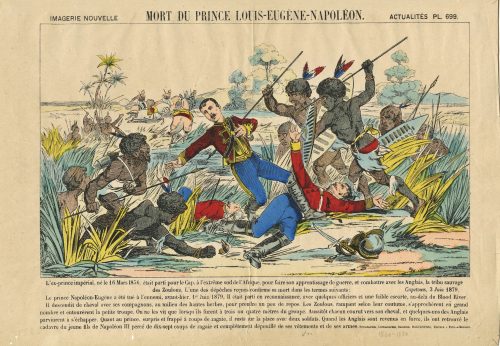 Hand-coloured lithography on wove paper, 275 x 385 mm; vertical centerfold, image in frame. On reverse: black ink stamp “5350”. Above the frame: "IMAGERIE NOUVELLE — MORT DU PRINCE LOUIS-EUGÈNE-NAPOLÉON. — ACTUALITÉS PL. 699". Under the frame: "L'ex-prince impérial, né le 16 Mars I856, était parti pour le Cap, à l'extrême sud de l'Afrique, pour faire son apprentissage de guerre, et combattre avec les Anglais, la tribu sauvage des Zoulous. L'une des dépêches reçues confirme sa mort dans les termes suivants: — Capetown, 3 Juin 1879. — Le prince Napoléon-Eugène a été tué à l'ennemi, avant-hier, 1er Juin 1879, Il était parti en reconnaissance, avec quelques officiers et une fable escorte, au-delà du Blood River. Il descendit de cheval ave ses compagnons, au milieu des hautes herbes, pour prendre un peu de repos. Les Zoulous, rampant selon leur coutume, s'approchèrent en grand nombre et entourèrent la petite troupe. On ne les vit que lorsqu' ils furent à trois ou quatre mètres du groupe. Aussitôt chacun court vers son cheval, et quelques-uns des Anglais parvinrent à s'échapper. Quant au prince, surpris et frappé à coups de zagaie, il resta sur la place avec deux soldats. Quand les Anglais sont revenus en force, ils ont retrouvé le cadavre du jeune fils de Napoléon III percé de dix-sept coups de zagaie et complétement dépouillé de ses vêtements et de ses armes". — "Typographie, Lithographie, Imagerie, Haguenthal, Éditeur à Pont-à-Mousson". Pencil ms: "1860-1880". Élie Haguenthal (French, 1822 – 1881) – publisher/printer.
Hand-coloured lithography on wove paper, 275 x 385 mm; vertical centerfold, image in frame. On reverse: black ink stamp “5350”. Above the frame: "IMAGERIE NOUVELLE — MORT DU PRINCE LOUIS-EUGÈNE-NAPOLÉON. — ACTUALITÉS PL. 699". Under the frame: "L'ex-prince impérial, né le 16 Mars I856, était parti pour le Cap, à l'extrême sud de l'Afrique, pour faire son apprentissage de guerre, et combattre avec les Anglais, la tribu sauvage des Zoulous. L'une des dépêches reçues confirme sa mort dans les termes suivants: — Capetown, 3 Juin 1879. — Le prince Napoléon-Eugène a été tué à l'ennemi, avant-hier, 1er Juin 1879, Il était parti en reconnaissance, avec quelques officiers et une fable escorte, au-delà du Blood River. Il descendit de cheval ave ses compagnons, au milieu des hautes herbes, pour prendre un peu de repos. Les Zoulous, rampant selon leur coutume, s'approchèrent en grand nombre et entourèrent la petite troupe. On ne les vit que lorsqu' ils furent à trois ou quatre mètres du groupe. Aussitôt chacun court vers son cheval, et quelques-uns des Anglais parvinrent à s'échapper. Quant au prince, surpris et frappé à coups de zagaie, il resta sur la place avec deux soldats. Quand les Anglais sont revenus en force, ils ont retrouvé le cadavre du jeune fils de Napoléon III percé de dix-sept coups de zagaie et complétement dépouillé de ses vêtements et de ses armes". — "Typographie, Lithographie, Imagerie, Haguenthal, Éditeur à Pont-à-Mousson". Pencil ms: "1860-1880". Élie Haguenthal (French, 1822 – 1881) – publisher/printer. -
 Three-quarter half-length seated portrait of American filmmaker and actor Woody Allen in a scene from the drama film The Front (1976), shot by Columbia Pictures in 1976, autographed on a light area of the image. Dimensions: 245 x 192 mm; image 217 x 192 mm.
Three-quarter half-length seated portrait of American filmmaker and actor Woody Allen in a scene from the drama film The Front (1976), shot by Columbia Pictures in 1976, autographed on a light area of the image. Dimensions: 245 x 192 mm; image 217 x 192 mm. -
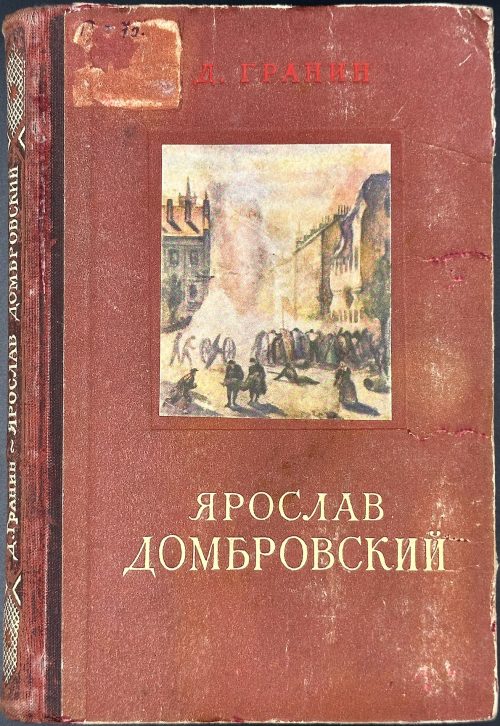 Hardcover, 20.4 x 14 cm, quarter burgundy cloth over paper boards with red and beige lettering and vignette to front and beige lettering to spine; pp.: [1-4] 5-182 [2], collation 8vo: 1-118 124, total 92 leaves. Design of binding and t.p. by В. Телепнев. Library pocket, stamps, and inscriptions. Title-page (red and black): Д. ГРАНИН | ЯРОСЛАВ | ДОМБРОВСКИЙ | ~ | ✸ | Издательство ЦК ВЛКСМ | “Молодая гвардия” | 1951 || Print run: 15,000 copies. Contributors: Даниил Александрович Гранин (Russian, 1919 – 2017) – author. Владимир Иванович Телепнев (Russian, 1906 – 1985) – artist. Jaroslaw Dombrowski [Jarosław Dąbrowski] (Polish-French, 1836 – 1871) – character.
Hardcover, 20.4 x 14 cm, quarter burgundy cloth over paper boards with red and beige lettering and vignette to front and beige lettering to spine; pp.: [1-4] 5-182 [2], collation 8vo: 1-118 124, total 92 leaves. Design of binding and t.p. by В. Телепнев. Library pocket, stamps, and inscriptions. Title-page (red and black): Д. ГРАНИН | ЯРОСЛАВ | ДОМБРОВСКИЙ | ~ | ✸ | Издательство ЦК ВЛКСМ | “Молодая гвардия” | 1951 || Print run: 15,000 copies. Contributors: Даниил Александрович Гранин (Russian, 1919 – 2017) – author. Владимир Иванович Телепнев (Russian, 1906 – 1985) – artist. Jaroslaw Dombrowski [Jarosław Dąbrowski] (Polish-French, 1836 – 1871) – character. -
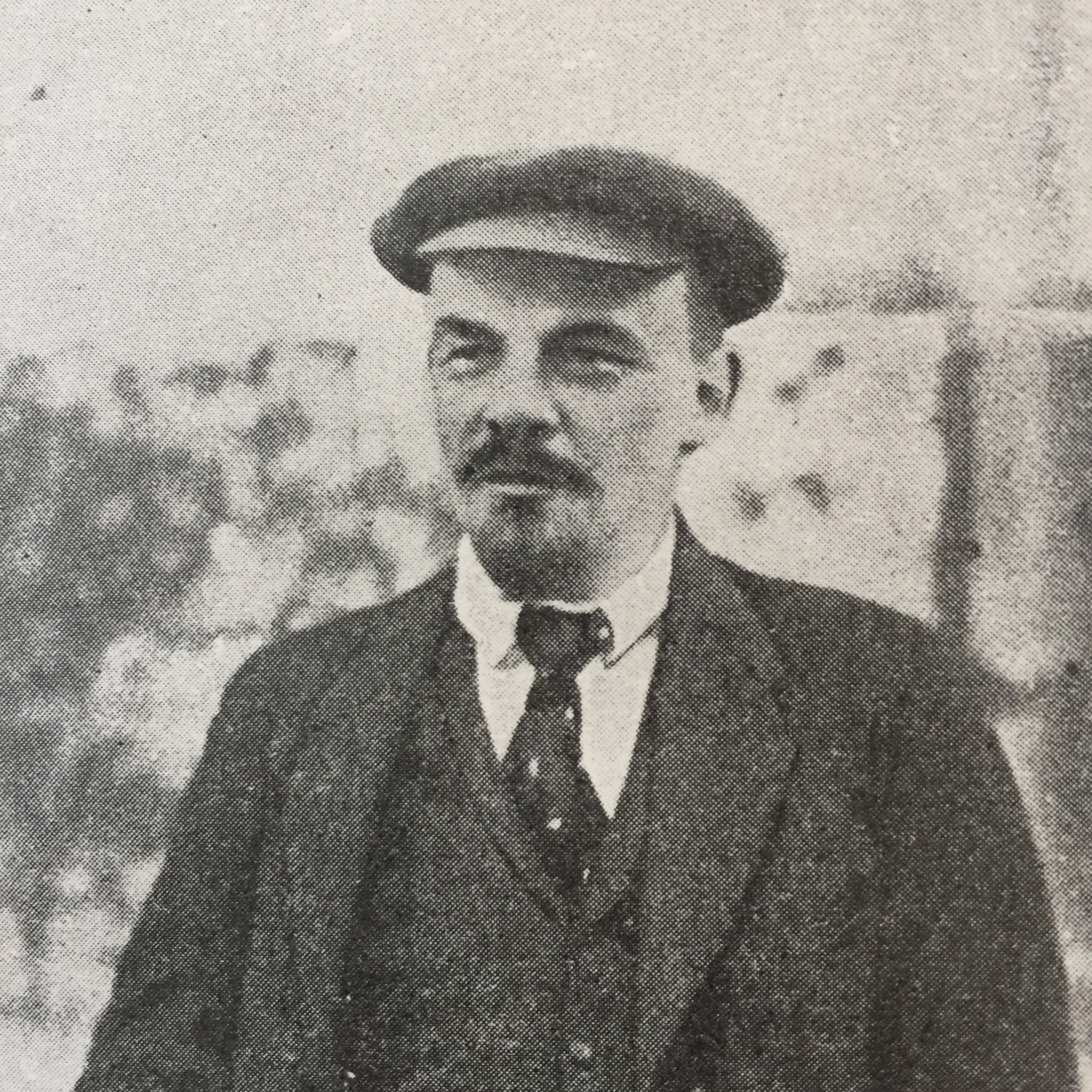
Каторга и ссылка. Историко-революционный вестник. Книга 8, № 1, 1924. Общество бывших политических каторжан и ссылно-поселенцев. Под общей редакцией Вл. Виленского (Сибирякова). Москва, 1924. Государственное издательство "Типография Печатный Двор", Ленинград. Тираж: 4,000 экз.
-
 Iron tsuba of round form decorated with inlay of four concentric rows of brass dots or nail heads (ten-zōgan) and a circular brass wire inlay inside the innermost row of dots. Copper sekigane. Muromachi period, 15th or 16th century. Unsigned. Ōnin school. Size: 87.9 x 87.8 x 2.2 mm. Ōnin school got its name from the Ōnin War (応仁の乱 - Ōnin no Ran) - a civil war that lasted 10 years (1467–1477) during the Muromachi period in Japan.
Iron tsuba of round form decorated with inlay of four concentric rows of brass dots or nail heads (ten-zōgan) and a circular brass wire inlay inside the innermost row of dots. Copper sekigane. Muromachi period, 15th or 16th century. Unsigned. Ōnin school. Size: 87.9 x 87.8 x 2.2 mm. Ōnin school got its name from the Ōnin War (応仁の乱 - Ōnin no Ran) - a civil war that lasted 10 years (1467–1477) during the Muromachi period in Japan. -
 Late 19th-century (1850-1870) Japanese export fan. This fan has a double leaf painted with a different design on either side. Ivory encrusted with gemstones and other materials. Subject matter such as women wearing kimono is also more typical of export than domestic products (V&A). Autumn theme on the reverse.
Late 19th-century (1850-1870) Japanese export fan. This fan has a double leaf painted with a different design on either side. Ivory encrusted with gemstones and other materials. Subject matter such as women wearing kimono is also more typical of export than domestic products (V&A). Autumn theme on the reverse. -
 Iron tsuba of oval form with design of iris and plank bridge (yatsubashi) in openwork (sukashi). Rounded cornered rim. Unsigned. Attributed to Jingo - 3rd generation Shimizu, 2nd generation Jingo (1691-1777) [M. Sesko, Genealogy..., p. 94]. Edo period: Late 18th century (Hohreki / Meiwa era). Height: 69.5 mm. Width: 65.2 mm. Rim thickness: 4.6 mm. Center thickness: 4.8 mm. Provenance: Sasano Masayuki Collection, № 251: "Shimizu. Third generation Jingo (died at 87 years of age in the sixth year of An-ei, 1777). The eight-section bridge with irises are arranged to create the design of 'yatsubashi'. The features are unique for the Shimizu school and show no influence of the Hirita, Nishigaki or Hayashi schools". The design visually resembles a butterfly. As described in Family Crests of Japan by Stone Bridge Press [Family Crests of Japan; Stone Bridge Press, Berkeley, CA, 2007], and also in Japanese Family Crests by Yuzuru Okada [Yuzuru Okada. Japanese Family Crests // Series: Tourist Library: 37. Board of tourist industry; Japanese Government Railways, - 1941], there is a special technique used in construction of family crests, called 'reshaping' by the former and 'reconstruction' by the latter: "reconstruction is realized when a motive has its general shape composed of the detail of entirely different motive as, for instance, the crest of a butterfly formed of pine-needles. [...] The fanciful and ingenious forms evolved in this way may be represented by the kasiwa-giri or 'oak-leaf-paulownia', the ogi-bisi or 'fan-lozenge', the matuba-zuru or 'pine-needle-crane', the omodaka-kotyo or 'water-plantain-butterfly', etc." In our case we can call the motif yatsubashi-chocho or 'Iris-and-Bridge—Butterfly'.
Iron tsuba of oval form with design of iris and plank bridge (yatsubashi) in openwork (sukashi). Rounded cornered rim. Unsigned. Attributed to Jingo - 3rd generation Shimizu, 2nd generation Jingo (1691-1777) [M. Sesko, Genealogy..., p. 94]. Edo period: Late 18th century (Hohreki / Meiwa era). Height: 69.5 mm. Width: 65.2 mm. Rim thickness: 4.6 mm. Center thickness: 4.8 mm. Provenance: Sasano Masayuki Collection, № 251: "Shimizu. Third generation Jingo (died at 87 years of age in the sixth year of An-ei, 1777). The eight-section bridge with irises are arranged to create the design of 'yatsubashi'. The features are unique for the Shimizu school and show no influence of the Hirita, Nishigaki or Hayashi schools". The design visually resembles a butterfly. As described in Family Crests of Japan by Stone Bridge Press [Family Crests of Japan; Stone Bridge Press, Berkeley, CA, 2007], and also in Japanese Family Crests by Yuzuru Okada [Yuzuru Okada. Japanese Family Crests // Series: Tourist Library: 37. Board of tourist industry; Japanese Government Railways, - 1941], there is a special technique used in construction of family crests, called 'reshaping' by the former and 'reconstruction' by the latter: "reconstruction is realized when a motive has its general shape composed of the detail of entirely different motive as, for instance, the crest of a butterfly formed of pine-needles. [...] The fanciful and ingenious forms evolved in this way may be represented by the kasiwa-giri or 'oak-leaf-paulownia', the ogi-bisi or 'fan-lozenge', the matuba-zuru or 'pine-needle-crane', the omodaka-kotyo or 'water-plantain-butterfly', etc." In our case we can call the motif yatsubashi-chocho or 'Iris-and-Bridge—Butterfly'. -
 Iron tsuba of oval form carved and inlaid in gold and copper with cormorant fisherman in disguise. Unsigned. Dimensions: 67.7 mm x 61.5 mm x 3.8 mm (at seppa-dai) Edo period: 18th century. "Since Nara period, Japanese fishermen in small boats have used cormorants (u) to catch river fish at night, binding the necks of the birds so that the fish are not swallowed. [...] The bird and the work it performs are symbols of selfless devotion to one's master and keen eyesight." - from Merrily Baird. Symbols of Japan. Thematic motifs in art and design. Rizzoli international publications, Inc., 2001; p. 104. See also TSU-0212 and TSU-0096
Iron tsuba of oval form carved and inlaid in gold and copper with cormorant fisherman in disguise. Unsigned. Dimensions: 67.7 mm x 61.5 mm x 3.8 mm (at seppa-dai) Edo period: 18th century. "Since Nara period, Japanese fishermen in small boats have used cormorants (u) to catch river fish at night, binding the necks of the birds so that the fish are not swallowed. [...] The bird and the work it performs are symbols of selfless devotion to one's master and keen eyesight." - from Merrily Baird. Symbols of Japan. Thematic motifs in art and design. Rizzoli international publications, Inc., 2001; p. 104. See also TSU-0212 and TSU-0096 -
 Katsukawa Shun'ei. The Sumo Bout between Yotsuguruma (right) and Yamaoroshi (left). Date: 1800 or 1805/06. Similar sheet can be found at Edo Tokyo Museum. Size: Vertical Ōban. Sumo wrestler Yotsuguruma Daihachi (1772 - 1809) first appeared in the records of national tournaments in winter of 1794. Then he lost 3 matches and won zero. He first won in the spring tournament of 1797 in a match against maegashira (the fifth-highest rank of sumo wrestlers) named Kougamine. Yamaoroshi Gengo (born 1762) came in at the winter tournament of 1799 . He was much more successful in his career than Yotsuguruma, but he had never won a tournament. It was the time of great Raiden, who won most of them. In the spring tournament of 1800 Yotsuguruma and Yamaoroshi fought against each other for the first time. Yotsuguruma lost. The next time they met on the ring was at the winter tournament of 1805, and again in 1806. Both matches were won by Yamaoroshi. Yamaoroshi retired in 1809; Yotsuguruma died in 1809.
Katsukawa Shun'ei. The Sumo Bout between Yotsuguruma (right) and Yamaoroshi (left). Date: 1800 or 1805/06. Similar sheet can be found at Edo Tokyo Museum. Size: Vertical Ōban. Sumo wrestler Yotsuguruma Daihachi (1772 - 1809) first appeared in the records of national tournaments in winter of 1794. Then he lost 3 matches and won zero. He first won in the spring tournament of 1797 in a match against maegashira (the fifth-highest rank of sumo wrestlers) named Kougamine. Yamaoroshi Gengo (born 1762) came in at the winter tournament of 1799 . He was much more successful in his career than Yotsuguruma, but he had never won a tournament. It was the time of great Raiden, who won most of them. In the spring tournament of 1800 Yotsuguruma and Yamaoroshi fought against each other for the first time. Yotsuguruma lost. The next time they met on the ring was at the winter tournament of 1805, and again in 1806. Both matches were won by Yamaoroshi. Yamaoroshi retired in 1809; Yotsuguruma died in 1809. -

Fuchi-kashira made of Shibuichi carved and inlaid with shakudō, gold, silver, and copper with the design of spider holding a fly on the fuchi, and other insects (ant-lion, wasp, and ant) on the kashira.
Fuchi: 35.1 mm. Kashira: 38.7 mm. Main material: Shibuichi. Other metals: shakudō, gold, silver, and copper. Decorative technique: iroe taka-zōgan. -
 Suzuki Harunobu (鈴木 春信; c. 1725 – 15 July 1770).
Suzuki Harunobu (鈴木 春信; c. 1725 – 15 July 1770).The Ide Jewel River, a Famous Place in Yamashiro Province (Ide no Tamagawa, Yamashiro no meisho), from the series The Six Jewel Rivers in Popular Customs (Fûzoku Mu Tamagawa).
Signed: Harunobu gaInscription - Poem: Koma tomete/ nao mizu kawan/ yamabuki no/ hana no tsuyu sou/ Ide no Tamagawa
References:MFA # 21.4540.
Waterhouse cat. #562; Pins, The Japanese Pillar Print (1982), #139; Ukiyo-e shûka 4 (1979), list #795.4, and supp. 2 (1982), pl. 565; Gentles, AIC cat. II (1965), p. 125, #201.


